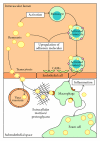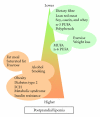Understanding postprandial inflammation and its relationship to lifestyle behaviour and metabolic diseases
- PMID: 21961070
- PMCID: PMC3179890
- DOI: 10.1155/2012/947417
Understanding postprandial inflammation and its relationship to lifestyle behaviour and metabolic diseases
Abstract
Postprandial hyperlipidemia with accumulation of remnant lipoproteins is a common metabolic disturbance associated with atherosclerosis and vascular dysfunction, particularly during chronic disease states such as obesity, the metabolic syndrome and, diabetes. Remnant lipoproteins become attached to the vascular wall, where they can penetrate intact endothelium causing foam cell formation. Postprandial remnant lipoproteins can activate circulating leukocytes, upregulate the expression of endothelial adhesion molecules, facilitate adhesion and migration of inflammatory cells into the subendothelial space, and activate the complement system. Since humans are postprandial most of the day, the continuous generation of remnants after each meal may be one of the triggers for the development of atherosclerosis. Modulation of postprandial lipemia by lifestyle changes and pharmacological interventions could result in a further decrease of cardiovascular mortality and morbidity. This paper will provide an update on current concepts concerning the relationship between postprandial lipemia, inflammation, vascular function, and therapeutic options.
Figures


Similar articles
-
The postprandial situation as a pro-inflammatory condition.Clin Investig Arterioscler. 2014 Jul-Aug;26(4):184-92. doi: 10.1016/j.arteri.2014.02.007. Epub 2014 May 25. Clin Investig Arterioscler. 2014. PMID: 24866730 Review.
-
Postprandial inflammation and endothelial dysfuction.Biochem Soc Trans. 2007 Jun;35(Pt 3):466-9. doi: 10.1042/BST0350466. Biochem Soc Trans. 2007. PMID: 17511629 Review.
-
Postprandial lipoproteins and the molecular regulation of vascular homeostasis.Prog Lipid Res. 2013 Oct;52(4):446-64. doi: 10.1016/j.plipres.2013.06.001. Epub 2013 Jun 15. Prog Lipid Res. 2013. PMID: 23774609 Review.
-
Postprandial triglycerides and endothelial function.Exp Clin Endocrinol Diabetes. 2001;109(4):S533-47. doi: 10.1055/s-2001-15116. Exp Clin Endocrinol Diabetes. 2001. PMID: 11453041 Review.
-
Novel aspects of postprandial lipemia in relation to atherosclerosis.Atheroscler Suppl. 2008 Sep;9(2):39-44. doi: 10.1016/j.atherosclerosissup.2008.05.007. Epub 2008 Jul 1. Atheroscler Suppl. 2008. PMID: 18595782 Review.
Cited by
-
Meals That Differ in Nutrient Composition and Inflammatory Potential Do Not Differentially Impact Postprandial Circulating Cytokines in Older Adults above a Healthy Weight.Nutrients. 2022 Apr 1;14(7):1470. doi: 10.3390/nu14071470. Nutrients. 2022. PMID: 35406083 Free PMC article.
-
Spices in a High-Saturated-Fat, High-Carbohydrate Meal Reduce Postprandial Proinflammatory Cytokine Secretion in Men with Overweight or Obesity: A 3-Period, Crossover, Randomized Controlled Trial.J Nutr. 2020 Jun 1;150(6):1600-1609. doi: 10.1093/jn/nxaa063. J Nutr. 2020. PMID: 32211803 Free PMC article. Clinical Trial.
-
Role of growth hormone-releasing hormone in dyslipidemia associated with experimental type 1 diabetes.Proc Natl Acad Sci U S A. 2016 Feb 16;113(7):1895-900. doi: 10.1073/pnas.1525520113. Epub 2016 Feb 1. Proc Natl Acad Sci U S A. 2016. PMID: 26831066 Free PMC article.
-
Orange juice with a high-fat meal prolongs postprandial lipemia in apparently healthy overweight/obese women.Arch Endocrinol Metab. 2017 May-Jun;61(3):263-268. doi: 10.1590/2359-3997000000229. Epub 2016 Nov 24. Arch Endocrinol Metab. 2017. PMID: 27901186 Free PMC article. Clinical Trial.
-
Patients with type 1 diabetes show signs of vascular dysfunction in response to multiple high-fat meals.Nutr Metab (Lond). 2014 Jun 13;11:28. doi: 10.1186/1743-7075-11-28. eCollection 2014. Nutr Metab (Lond). 2014. PMID: 24959195 Free PMC article.
References
-
- Braunwald E. Shattuck lecture—cardiovascular medicine at the turn of the millennium: triumphs, concerns, and opportunities. New England Journal of Medicine. 1997;337(19):1360–1369. - PubMed
-
- Halkes CJM, Van Dijk H, De Jaegere PPT, et al. Postprandial increase of complement component 3 in normolipidemic patients with coronary artery disease: effects of expanded-dose simvastatin. Arteriosclerosis, Thrombosis, and Vascular Biology. 2001;21(9):1526–1530. - PubMed
-
- Bansal S, Buring JE, Rifai N, Mora S, Sacks FM, Ridker PM. Fasting compared with nonfasting triglycerides and risk of cardiovascular events in women. Journal of the American Medical Association. 2007;298(3):309–316. - PubMed
-
- Nordestgaard BG, Benn M, Schnohr P, Tybjærg-Hansen A. Nonfasting triglycerides and risk of myocardial infarction, ischemic heart disease, and death in men and women. Journal of the American Medical Association. 2007;298(3):299–308. - PubMed
LinkOut - more resources
Full Text Sources
Other Literature Sources

